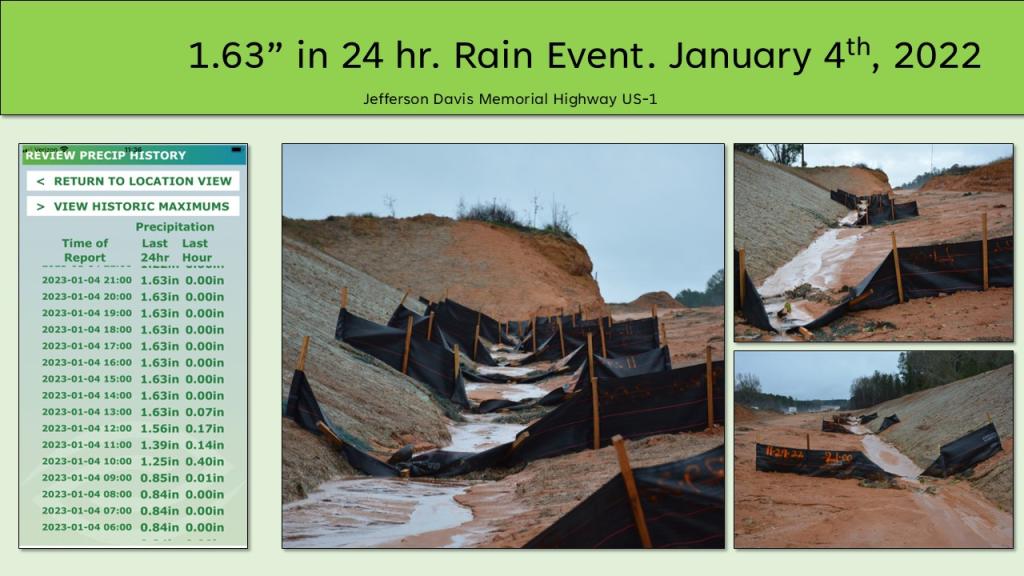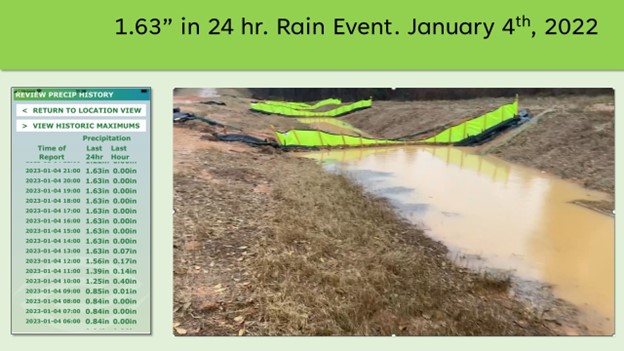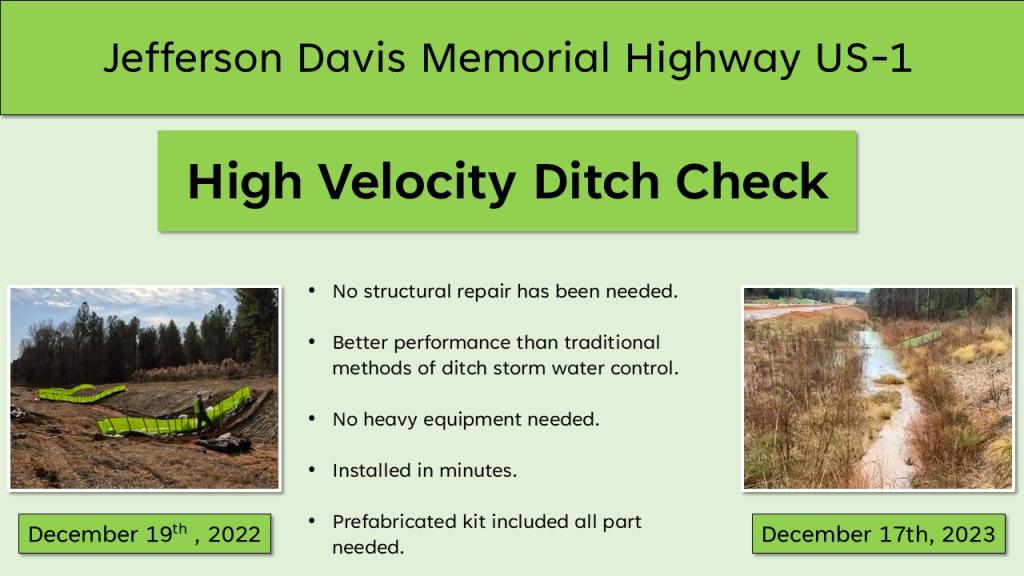
Silt Saver is proud to present a case study on the Georgia Department of Transportation test site of the High Velocity Ditch Check 24.
A video version of the Case Study is available below.


Introduction: The installation of a High Velocity Ditch Check along the Jefferson Davis Memorial Highway US-1 in Georgia marks an important development for sediment control in channels. This project aimed to provide an effective and low-maintenance solution to control runoff velocity, minimize sediment transport and promote channel stabilization without the need for heavy equipment or extensive labor. Georgia Department of Transportation evaluated the Silt Saver High Velocity Ditch Check to determine effectiveness resulting in “High Velocity Ditch Check” NPE 2207-2 being classified as “Accepted”.
Case Study: High Velocity Ditch Check performance during Georgia DOT field performance evaluation
Product: Silt Saver – High Velocity Ditch Check
Location: Jefferson Davis Memorial Highway US-1, Georgia
Installation Date: December 19th, 2022
Objective: To control runoff velocity, minimize sediment transport, and provide for channel stabilization.

Installation Details: The High Velocity Ditch Check 24 was installed on December 19th, 2022. This prefabricated kit required minimal installation time and no heavy machinery, significantly reducing the installation footprint and time. Four High Velocity Ditch Check 24s replaced five of the GDOT traditional fabric check dams.

The High Velocity Ditch Checks are available in two sizes 24-foot trapezoidal and 14-foot v-ditch. The High Velocity Ditch Checks are preassembled and sold as a kit to ensure quality control and consistency of installation.
The kit consists of a high visibility green velocity restrictor sheet prefabricated with posts and attached skirt. The posts are attached to match the contour of the channel – nominally 3:1 front slope and back slope. The skirt is used as a front water seal and rear scour guard to prevent undermining and rear scouring. An additional rear scour guard extension is provided to further reduce channel scouring.
Compression tubes filled with kiln dried wood chips and compression stakes dissipate the initial force of stormwater and sediment. This allows the green velocity restrictor sheet to act much like a level spreader to release the storm water in a controlled manner.
On January 4th, 2022 a 1.63” rain event occurred. Up channel of the High Velocity Ditch Check 24 test site, ten traditional fabric check dams completely failed releasing the storm water downstream to the test site.

The four High Velocity Ditch Checks successfully slowed and controlled the stormwater runoff from the ten failed up channel check dams and the GDOT test site. Even under these extreme conditions, the High Velocity Ditch Check 24s performed as expected.
A video of this event may be viewed on the www.siltsaver.com website.

The following are the monthly rainfall figures and corresponding photos.




On April 18th, 2023, Georgia Department of Transportation listed the High Velocity Ditch check as “Accepted”.

Silt Saver continued to monitor performance on the test site.

Silt Saver Inc. documented the process of removing sediment build-up from the high visibility velocity restrictor sheet in a video filmed for the case study in June 2023.
The video demonstrates the simple method of dislodging the sediment buildup. No structural repairs or replacements have been necessary.



The traditional fabric check dams, located up channel, repeatedly failed during the monitoring period. Due to these failures, the High Velocity Ditch Check 24s were forced to handle a significantly increased volume of storm water during rainfall events.

In December 2023 Silt Saver announced the documented results of one year on the GDOT project.

After receiving 69.14 inches of storm water by the end of December 2023, the High Velocity Ditch Checks had achieved the stated goals of an effective and low-maintenance solution to control runoff velocity, minimize sediment transport and promote channel stabilization without the need for heavy equipment or extensive labor.


On June 7th, 2024, Silt Saver revisited the test site. This addendum documents the additional rainfall and conditions of the GDOT High Velocity Ditch Check test site.

The traditional check dams continued to demonstrate failures resulting in additional storm water flow to the down channel High Velocity Ditch Check 24s.

Natural vegetative growth was permitted to grow.
By providing controlled storm water flow in the channel, the High Velocity Ditch Check 24s facilitated the establishment of vegetation within the channel.

The following are pictures of the four High Velocity Ditch Checks still performing the function of a check dam 18 months after installation.


On June 7th, 2024, the following observations were made.

The High Velocity Ditch Check 24s are continuing to be evaluated and approved in other states.

Conclusion: The implementation of the High Velocity Ditch Check along the Jefferson Davis Memorial Highway US-1 proved to be a successful intervention. By leveraging innovative design and prefabricated components, the project effectively managed storm water runoff while promoting vegetative establishment and reduced labor costs. This project stands as a model for future initiatives aimed at controlling runoff velocity and stabilizing channels in similar contexts.



